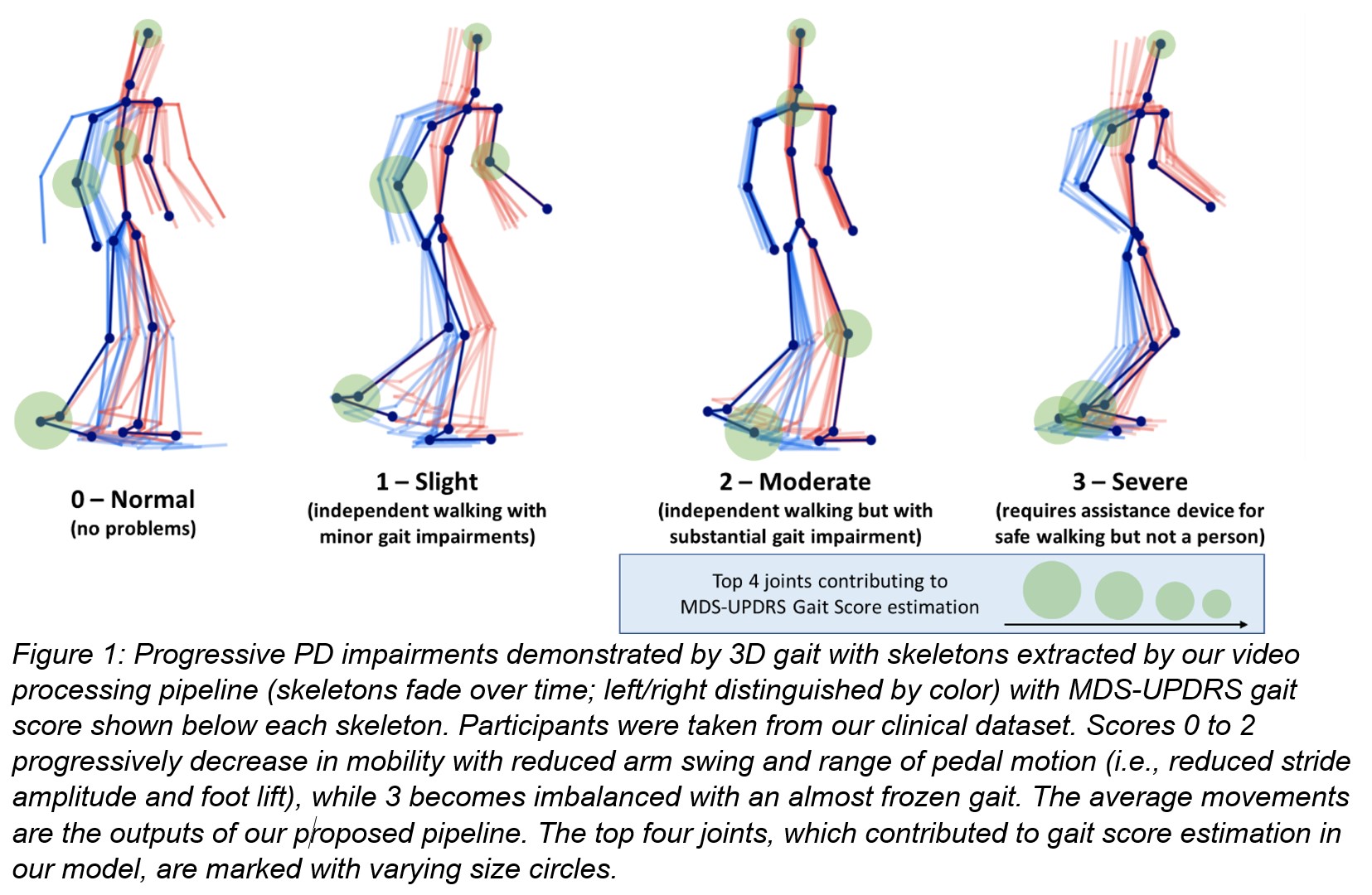Category: Technology
Objective: Early diagnosis of Parkinson’s disease (PD) and tracking its signs are crucial for developing treatment plans. The MDS-Unified Parkinson’s Disease Rating Scale (MDS-UPDRS) defines a universal scoring scheme to measure PD severity. We used the video of participants’ MDS-UPDRS gait test and built a system to quantify PD motor severity1. To combat the multi-rater disagreements, we developed a method based on machine learning for robust score estimation, agnostic to single rater habits or preferences.
Background: Prior work for assessment of PD motor signs often used costly and intrusive wearable sensors2. Alternatively, video technology offers a contactless, scalable, non-intrusive platform for quantifying and tracking movement disturbances. Using novel deep-learning technologies, video processing can now accurately quantify movements3. These approaches have yet to be applied to the clinical setting.
Method: We reduced the participants’ gait videos (N=55) to a few body markers (3D skeleton joints). They were then fed to a neural network that estimated the MDS-UPDRS gait scores (0 to 3; we excluded score 4 due to the difficulty in obtaining videos). We used ratings from 3 expert neurologists. Together with training our neural network, our model learned each rater’s rating habits to resolve disagreements and make one final score estimation. We used accuracy and area under the curve (AUC) to measure the quality of estimation compared to rater majority voting and utilized Cohen’s coefficient (κ) to measure the agreement between estimations and the majority votes.
Results: When compared to the majority vote from the 3 raters, our method obtained an average accuracy of 72% (null-hypothesis=25% accuracy) and AUC of 0.83, significantly better than the null classifier based on permutation testing (one-tailed p<0.0001). Fig. 1 shows the skeletons extracted by our pipeline and the top 4 joints contributing the most in classifying each score. Our method’s κ of 0.49 was significantly higher than the κ of all rater pairs, which were 0.38, 0.39, and 0.30.
Conclusion: Our method automatically estimated PD severity of gait disturbances from MDS-UPDRS exams. Our video processing approaches can readily be used for tracking gait disturbance severity in PD or (or other movement disorders), essential for determining aids to maintain postural stability. Non-contact assessment is of particular interest in the ongoing COVID-19 pandemic.
References: [1] Lu, M., Poston, K., Pfefferbaum, A., Sullivan, E.V., Fei-Fei, L., Pohl, K.M., Niebles, J.C., Adeli, E., (2020). Vision-based estimation of MDS-UPDRS gait scores for assessing Parkinson’s disease motor severity, in: Medical Image Computing and Computer-Assisted Intervention, Springer. pp. 637–647. PMCID: PMC7585545 [2] Marcante, A., Di Marco, R., Gentile, G., Pellicano, C., Assogna, F., Pontieri,F.E., Spalletta, G., Macchiusi, L., Gatsios, D., Giannakis, A., et al., (2021). Foot pressure wearable sensors for freezing of gait detection in Parkinson’s disease. Sensors 21, 128. [3] Kocabas, M., Athanasiou, N., & Black, M. J. (2020). VIBE: Video inference for human body pose and shape estimation. In Proceedings of the IEEE/CVF Conference on Computer Vision and Pattern Recognition, pp. 5253-5263.
To cite this abstract in AMA style:
E. Adeli, E. Sullivan, M. Lu, Q. Zhao, L. Montaser Kouhsari, M. Katz, A. Pfefferbaum, K. Pohl, V. Henderson, K. Poston. Automatic Estimation of MDS-UPDRS Gait Scores from Videos with Multi-Rater Disagreements [abstract]. Mov Disord. 2021; 36 (suppl 1). https://www.mdsabstracts.org/abstract/automatic-estimation-of-mds-updrs-gait-scores-from-videos-with-multi-rater-disagreements/. Accessed December 29, 2025.« Back to MDS Virtual Congress 2021
MDS Abstracts - https://www.mdsabstracts.org/abstract/automatic-estimation-of-mds-updrs-gait-scores-from-videos-with-multi-rater-disagreements/

